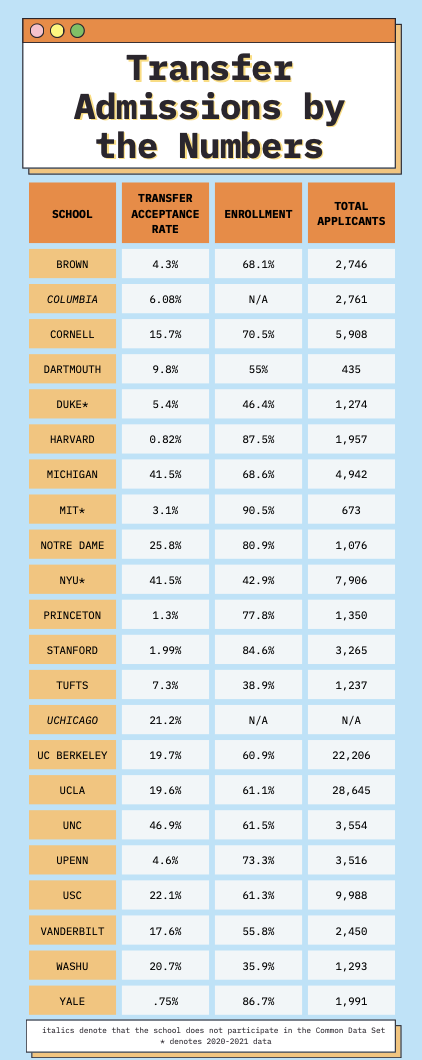It might seem early to talk about transferring, but we don’t believe in early. The moment you find yourself unhappy with your current school or catch yourself wondering if the grass is really greener on another campus, we say apply. Why? Because transfer admissions, for lack of a better term, are kind of a crap shoot.
When you transfer, you’re essentially betting on the fact that students are going to be leaving their current institution (perhaps your dream school,) therefore giving you a coveted spot in the class. Transferring also requires a lot of specificity. It might have been enough the first time around to apply undecided (something we never suggest btw) and with like, zero extracurriculars that back up your interests, but that won’t cut it this time. Especially if you’re thinking of applying to a top-tier school. They need to know that their school is the only school for you. You have to convince them that school is your soulmate (schoolmate) (sorry) and you can only achieve your extremely niche goals by utilizing their resources. Basically, it’s going to be a lot harder this time around. But not impossible – all of our transfer clients have gotten into one of their top 3 schools.
We’ve talked about the Transfer-Up Myth on the blog before, but to back up our stance, we’ve compiled data from the most popular schools with our clients to show you that transferring is so much more art than science.
Getting this data was a little bit (okay, a lot a bit) like pulling teeth. Schools hold this data close to the chest because they want you to apply! They want you to have as much hope as is humanly possible. We googled. We scoured their admissions offices’ websites. We even, in a moment of desperation, turned to Reddit. But then, a lightbulb moment. The Common Data Sets.
All but two schools in our chart use the CDS, Columbia and UChicago. (I guess the CDS isn’t the only thing Columbia doesn’t want to be part of anymore!) Columbia is extra annoying in the transfer process as they only accept the Coalition Application for transfers instead of the Common App, like every other school. Even though both Columbia and UChicago publish some of their own data, neither seemed to pay much attention to transfer students, so the data we have for them is mostly approximation. Sometimes these schools hide their CDS deep in the indexes of a statistical office’s archive. Not all schools had the most recent 2021-2022 CDS either, including Duke, MIT, and NYU, so we leaned on the 2020-2021 CDS data.
“Oh boy” you think to yourself. “These acceptance rates are better than overall acceptance rates at some of these schools! Dartmouth here I come!!!” Bzzzt. Wrong! Try to shake that mindset out now, because those numbers are a little deceiving. Take Dartmouth for example. The 9.8% acceptance rate for transfers is higher than their most recent acceptance rate of 6.2%, but put that into perspective. Last cycle, over 28,000 people applied for a little over 1,200 spots. For transfers, 435 people applied for only 43 spots.
It's easy to see a percentage rate and automatically assume that’s your percentage chance of getting in – but you have to remember you’re fighting for hundreds -- if not tens -- of spots, not thousands.
Another interesting thing to note is enrollment, and you can see in most cases that the more selective the school, the higher the enrollment for transfers. MIT has an enrollment rate of 90.5% for transfers, because out of the 21 people admitted, 19 enrolled. That’s 3 people who said no thanks to MIT. Maybe they were part of the 65 who got into Stanford (which side note, Stanford filled out their CDS wrong which is… sloppy! You can’t enroll more people than applied to Stanford, ), the 16 who got into Harvard, or the 15 who got into Yale.
Also interesting are schools with less than 50% transfer enrollment rates, like Duke, NYU, WashU, and Tufts. Our theory is the kids who didn’t enroll there took our tried-and-true strategy: throw a bunch of stuff at the wall and see what sticks. Those four schools are excellent, with tons of our clients applying for first year, but if you did really well your first year of college, built your narrative, found your niche, and wrote killer essays (perhaps with the help of a counselor *wink*), you’re probably a competitive applicant to a number of schools in the same tier.
All the Ivy Leagues (except Cornell, which is a whole thing) have single-digit (or, not even whole digit) acceptance rates, which is in line with the exclusivity we’ve come to expect from them. Getting into these schools is hard, and while sure, some of these schools have transfer acceptance rates higher than their general acceptance rates, that doesn’t guarantee a better shot of admission. You have to make yourself a competitive applicant, which means kicking ass in your classes, getting involved on campus (even if you don’t love it), and developing an expertise in your academic passion. And getting into your dream school the second time around isn’t a guarantee, so you also need to find ways to plug into your current school just in case.
If you’re thinking about applying and don’t know where to start, we’re ready to help you. We are experts at transferring – like we said, all of our transfer clients have gotten into one of their top 3 schools. Transferring can be messy, confusing, emotional, stressful, and exhausting.
Reach out today and let us help you cut the clutter and carry some of the stress so you can have the best application possible.
